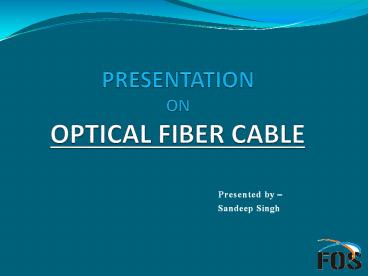Fibre Optic Systems - PowerPoint PPT Presentation
Title:
Fibre Optic Systems
Description:
Fibre Optic Systems(FOS) is a fibre optic supplier & manufacturer in Australia, specialising in fibre optic cords, cables & fibre optic test equipment. – PowerPoint PPT presentation
Number of Views:354
Title: Fibre Optic Systems
1
Presented by Sandeep Singh
2
Brief flow of presentation
- Introduction
- What are Optical Fibers ?
- Structure of optical fiber
- Working principle of optical fiber
- Optical fiber communication system
- Advantage / Disadvantage of optical fiber
- Application of optical fiber
- Conclusion
3
What is Optical Fiber ?
? An optical fiber is a hair thin cylindrical
fiber of glass or any transparent dielectric
medium.
- The fiber which are used for optical
communication are wave guides made of
transparent dielectrics. - Its function is to guide visible and infrared
light over long distance.
4
Structure of optical fiber
5
Conti
- Core- central tube of very thin size made up of
optically transparent dielectric medium and
carries the light form transmitter to receiver.
The core diameter can vary from about 5um-100
um. - Cladding- outer optical material surrounding the
core having reflecting index lower than core. It
helps to keep the light within the core
throughout the phenomena of total internal
reflection. - Buffer Coating- plastic coating that protects the
fiber made of silicon rubber. The typical
diameter of fiber after coating is 250-300um.
6
Classification of optical fiber
- Optical fiber is classified into two categories
based on- - The number of modes-
- Single mode fiber(SMF) and
- Multi-mode fiber(MMF)
- 2) The reflective index-
- Step index optical fiber
- Graded- index optical fiber
7
On basis of number of modes-
Single mode fiber-
- In single mode fiber only one mode can propagate
through the - fiber.
- It has small core diameter (5um) and high
cladding diameter (70um). - Difference between the refractive index of core
and cladding is - very small.
- There is neither dispersion nor degradation
therefore it is suitable for long distance
communication. - The light is passed through the single mode fiber
through laser diode.
8
Multi- mode fiber
- It allows a large number of modes for
- light ray travelling through it.
- The core diameter is 40um and that of cladding
is 70um. - The relative refractive index difference is also
large than single mode fiber. - There is signal degradation due to multimode
dispersion. - It is not suitable for long distance
communication due to large dispersion and
attenuation of signal.
9
On the basis of refractive index
- ? There are two type of optical fiber-
- Step index optical fiber
- Graded- index optical fiber
10
Single Index fiber-
- Step-index optical fiber-the refractive index of
core and cladding are constant. - The light ray propagate through it in the form of
meridiognal rays which cross the fiber axis
during every reflection at the core cladding
boundary. - Graded Index Fiber-
- In this type of fiber core has a non uniform
refractive index that gradually decrease from
the center towards the core cladding interface. - The cladding has a uniform refractive index.
- The light rays propagate through it in the form
of helical rays. They never cross the fiber axis.
11
Optical Fiber Communication System
- Information source- it provide an electrical
signal to a transmitter comprising an electrical
stage. - Electrical transmitter- It drives an optical
source to give an - modulation of the light wave carrier.
- Optical source- It provides the
electrical-optical conversion. It may be a
semiconductor laser or an LED.
12
Continue..
- Optical cable- It serve as transmission medium.
- Optical detector- It is responsible for optical
to electrical conversion of data. It may be a
photodiodes, phototransistors or
photoconductors. - Electrical receiver It is used for electrical
interfacing at the receiver end of the optical
link and to perform the signal processing
electrically. - Destination It is the final point at which we
receive the information in the form of
electrical signal.
13
Advantage of Optical Fiber
- Immense bandwidth to utilize
- Total electrical isolation in the transmission
medium - Very low transmission loss
- Small size and light weight
- High signal security
- Very low power consumption and wide scope of
system expansion etc.
14
Conclusion
At the last, there are some negatives of using
optical fiber communication system in terms of
splicing, coupling, set up expenses etc. but it
is an un avoidable fact that optical fiber has
revolutionized the field of communication. As
soon as computers will be capable of processing
optical signals, the total arena of
communication will be opticalized immediately.
15
Contact us
Address 25 Gilbert Park Drive, Knoxfield,
Victoria 3180 Australia Phone no. -61435390490
61 478716543
61 399001936
Website https//www.fibreoptic.com.au/
16
Thank you..































